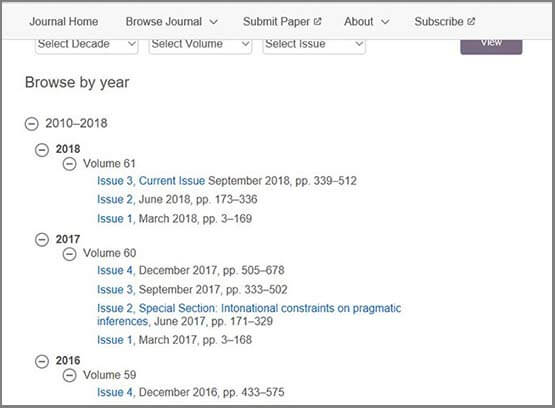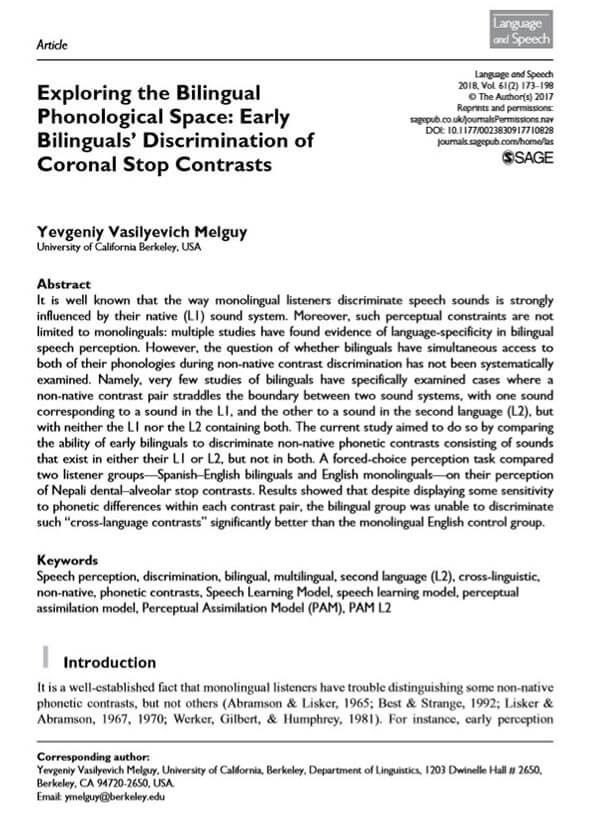With Components & Examples

Inhaltsverzeichnis
Definition: How to Cite an Article
You are probably just about to finish your paper and are now looking for a quick way to find out how to cite an article. For your paper to appear professional, it is necessary to cite every source you have used correctly. Citing an article differs from citing other references, such as books or websites. This article will show you how to cite an article.
What exactly is an article in an academic context?
Journal article
An article is a dependent work (unlike a monograph), because articles are published in journals that are often online publications. Scientific journals are published at regular intervals.
Consequently, a full citation of journal articles requires the volume number and, if possible, also the issue number (cf. Lück & Henke 2009: 83).
Example: Journal Language and Speech: Browsing the volumes of this journal shows that it is published quarterly (four issues); clicking on the individual issue number lead to the articles.

FAQs
A citation is a way of referencing to a published or unpublished source of information that was used in the writing of a journal or research paper. Citations give your readers specific information on sources of the information contained in the text. These citations are written at the end of the report, usually in alphabetical order. This greatly helps the writer avoid plagiarism when writing especially long texts.
Every source used in academic writing must always be cited. Citations for online articles are written as follows: write the author(s) name(s), name of the article in quotation marks, title of the publication in italics, volume and issue numbers of the source, and the year of publication. Be sure that you change the formatting of the citation to suit the referencing style you’re using.
This type of citation pertains to work obtained from electronic sources on the internet. This is especially complicated and different from the norm because online information can be easily changed, edited, deleted or they just disappear for numerous reasons. It is therefore advised that you store these sources personally by making copies of all the files you used. The exact formatting of an online article citation depends on the referencing style that you’re using. Scroll down for further information about specific citations with each referencing method.
Tip: If you’re not confident with your referencing skills, run your academic work through a plagiarism checker before you hand it in.
Citing an article used when writing has numerous important purposes. One of which is because it helps the writer avoid plagiarizing other writers’ works that were utilized for the academic writing process. It also provides the readers with details about where to find more information about sources mentioned in the text. Plus, it helps the writer to keep track of all the sources they’ve referenced whilst writing.
There are three (3) major styles of citing across the board (article, book, etc). They are as follows:
a. The APA Style (American Psychological Association): This is an author-year system of citation that ensures that the sources you are referencing can be tracked easily. This style is mostly used for Education, Psychology, and Science writings.
b. The MLA Style (Modern Language Association): This style uses the author-page system of in-text citation. It is popularly referred to as the college writing citation style. It is used for writing in the Humanities field.
c. The Chicago Style: This is an extremely flexible style of citation that unites two referencing styles (footnotes or author-year system) in one manual of style. It is used for Business, History, and Fine Arts writings.
They ultimately defer in the order in which the properties are cited. However, their contents are similar in all three cases.
Components of Full Citations
The following table (cf. APA manual 2010; Oertner, St. John, & Thelen 2014: 48-49) lists all elements that are part of a full citation of a journal article, including examples for each component. The author of the article is a crucial element of the full citation. Each entry in the reference list starts with the author’s surname.
| Components of the citation | Mandatory | Examples | Comments: How to cite an article |
| Author of the article | Yes | - Seidel, Brigitte; Schmitt, Peter A. - Gilbert, D. G. (APA style) - n. a. |
- The first name is written in full, the middle name abbreviated. However, this also depends on the citation style chosen: in APA citations, both first name and middle name are abbreviated. - n.a. = no author - The surname is part of the short reference in the text, if there are more than three authors: Name (first author) et al. (e.g. Shotton et al.). |
| Article title | Yes | - “The geographic expansion of Mexican immigration in the United States and its implications for local law enforcement” -“Volunteer support, marital status, and the survival times of terminally ill patients” |
Recommendation: Put the title in quotation marks; this indicates that it is a dependent work. Please note: No quotation marks in APA Citations! |
| In: | Depends on citation system | - , in: - . In: |
- Indicates that the article is embedded in a larger publication (the journal) - Capitalized only after a period Please note: No in/In in APA citations, the article title is directly followed by the italicized journal title. |
| Journal title | Yes |
- Health Psychology - Law Enforcement Executive Forum Journal - Journal of Applied Linguistics |
Title in italics (= independent publication) |
| Volume/Issue number and date/year of publication | Yes | - 28/1 (28th volume issue no. 1) - 2(2) (APA style) - 22.03.2015 |
- Journal articles: volume and issue number - For newspaper articles: day, month, year - Date of publication (APA citation: in brackets, right after the author) |
| Page numbers | Yes | - p. 145-168 - 25-59 - 63 et seq. |
- Please note: The page numbers do not refer to pages from which quotes were extracted, but refer to the placement of this particular article in the whole journal. - ff. = the following page; et seq. = subsequent pages (min. 2); if you are referring to more than three pages here, use a dash to indicate from-till: p. 267-275 |
Crucial Elements for Citing an Article
Author: When it comes to journal articles, the author of the article is named first (not the editor of the journal). The surname is followed by the first name. If there is more than one first name, only the first is written in full and the middle name is abbreviated, e.g. Schmitt, Peter A. However, if you are using APA citations, all first names are abbreviated and only the surname is written in full, e.g. Schmitt, P.A.
Journal title: Another vital element is the title of the journal. Depending on the citation system you choose to follow, the title is put in quotation marks. The title of the journal is also part of a full citation and must be italicized to contrast it with the title of the article. Thus, it is possible to distinguish article and journal title at a glance.
Volume Number: Moreover, you have to include the volume number to make sure that the article can be easily found and identified. In addition, the page numbers must be given as this also helps the reader trace your source.
Different Citation Systems
The above table has all the necessary information components that you must include when citing an article. However, the order of the information presented above differs depending on the citation system you are using.
You have to make sure that you consistently follow the same citation style when citing an article or other sources in general, e.g. APA style or Chicago Manual. The latter systems are so-called author/year (or date) systems which means parenthetical references are used in the text (author, year, page number). Short references in the text are directly linked to the full reference in the reference list.
Recommended: How to cite a book
The APA style is frequently used, and there are many reference lists of published works which follow this system. Maybe you came across the term “Harvard Style”. However, this is not a Manual of Style like the APA Style and the Chicago Manual. Bear in mind that Harvard Referencing is just “another name for the author/date citation system, the custom of using author and date in parentheses, e.g. (Robbins 1987), to refer readers to the full bibliographic citations” (cf. Harvard Library 2018, Chernin 1988).
To Cite an Article in APA Style
If you want to cite an article in APA style, you have to start with the author of the article. The surname is mentioned first. This is followed by the year of publication in brackets, the title of the article (no quotation marks), and the title of the journal in italics. The volume and issue number come right after the journal title, and then page numbers. The reference list is ordered alphabetically based on the first letters of the surnames of the authors who are cited.
Examples of Citing Articles in APA Style
The table below shows the general reference form for citing articles in APA style and three examples (cf. APA manual 2010: 198-199 & Szuchman 2005: 103.).
|
General reference form: Author, A. A., Author, B. B., & Author, C. C. (year). Title of article. Title of periodical, xx, pp-pp. doi:xx.xxxxxxxxx |
|
Offline Journal article Rogers, M., McDonald, R., & Kermit, F. (2002). Not all creatures wear sweaters. Children’s Television Review, 14, 12-30. |
|
Journal article with DOI Herbst-Damm, K. L., & Kulik, J. A. (2005). Volunteer support, marital status, and the survival times of terminally ill patients. Health Psychology, 24, 225-229. doi:10.1037/0278-6133.24.2.225 |
|
Journal article without DOI Silick, T. J., & Schutte, N. S. (2006). Emotional intelligence and self-esteem mediate between perceived early parental love and adult happiness. E-Journal of Applied Psychology, 2(2), 38-48. Retrieved from http://ojs.lib.swin.edu.au/index.php/ejap |
Citing an Article: Short References in the Text
First citation in the text (three authors): (Rogers, McDonald, & Kermit, 2002); subsequent citations in the text:
- (Rogers et al., 2002)
- (Herbst-Damm & Kulik, 2005)
- (Silick & Schutte, 2006)

Journal article as accessed and downloaded. See top of the page on the right-hand side: information regarding volume, issue number, year of publication, and name of journal.
In a Nutshell
- An article is a dependent work, as it is published in a journal (among other articles). A journal is published at regular intervals, e.g. three or four times a year.
- A full citation of an article includes: the name of the author of the article, the title of the article, the title of the journal, the volume number, the issue number, the year of publication, and the page numbers (for APA citation also DOI).
- Different citations systems have different rules on how to order the elements in an entry in the reference list, but they all draw on the same kind of information.
- Author/year systems such as APA style and Chicago Manual (as well as Harvard Style, which is just another term for author/year system) require short references in the text which directly refer to full citations in the reference list.
References
APA manual (2010). Publication Manual of the American Psychological Association. Washington, DC: American Psychological Association.
Chernin. 1988. The “Harvard System”: a mystery dispelled. British Medical Journal 297: 1062-1063.
Harvard Library. Oct 24, 2018. Citation and Research Management Tools at Harvard – Harvard Style. Retrieved Oct 25, 2018 from the World Wide Web: https://guides.library.harvard.edu/cite/guides.
Lück, Wolfgang, Michael Henke. 2009. Technik des wissenschaftlichen Arbeitens – Seminararbeit, Diplomarbeit, Dissertation. 10th ed. Oldenbourg Verlag: München.
Oertner, Monika, Illona St. John & Gabriele Thelen. 2014. Wissenschaftlich Schreiben – Ein Praxisbuch für Schreibtrainer und Studierende. Paderborn: Wilhelm Fink.
Szuchman, Leonore T. 2005. Writing With Style – APA Style Made Easy. 3rd edition. Canada: Thomson Wadsworth.

